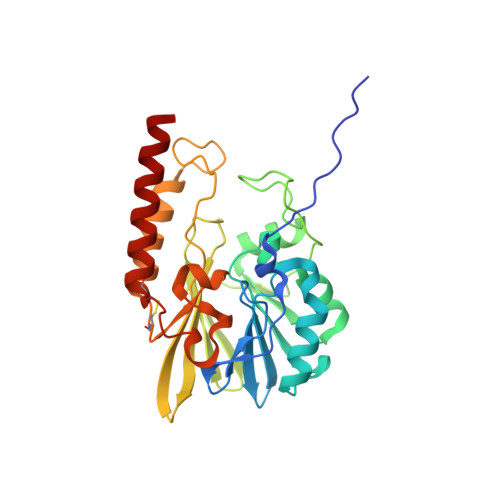Crystallography and QM/MM Simulations Identify Preferential Binding of Hydrolyzed Carbapenem and Penem Antibiotics to the L1 Metallo-beta-Lactamase in the Imine Form.
Twidale, R.M., Hinchliffe, P., Spencer, J., Mulholland, A.J.(2021) J Chem Inf Model 61: 5988-5999
- PubMed: 34637298
- DOI: https://doi.org/10.1021/acs.jcim.1c00663
- Primary Citation of Related Structures:
7O0O - PubMed Abstract:
Widespread bacterial resistance to carbapenem antibiotics is an increasing global health concern. Resistance has emerged due to carbapenem-hydrolyzing enzymes, including metallo-β-lactamases (MβLs), but despite their prevalence and clinical importance, MβL mechanisms are still not fully understood. Carbapenem hydrolysis by MβLs can yield alternative product tautomers with the potential to access different binding modes. Here, we show that a combined approach employing crystallography and quantum mechanics/molecular mechanics (QM/MM) simulations allow tautomer assignment in MβL:hydrolyzed antibiotic complexes. Molecular simulations also examine (meta)stable species of alternative protonation and tautomeric states, providing mechanistic insights into β-lactam hydrolysis. We report the crystal structure of the hydrolyzed carbapenem ertapenem bound to the L1 MβL from Stenotrophomonas maltophilia and model alternative tautomeric and protonation states of both hydrolyzed ertapenem and faropenem (a related penem antibiotic), which display different binding modes with L1. We show how the structures of both complexed β-lactams are best described as the (2 S )-imine tautomer with the carboxylate formed after β-lactam ring cleavage deprotonated. Simulations show that enamine tautomer complexes are significantly less stable (e.g., showing partial loss of interactions with the L1 binuclear zinc center) and not consistent with experimental data. Strong interactions of Tyr32 and one zinc ion (Zn1) with ertapenem prevent a C6 group rotation, explaining the different binding modes of the two β-lactams. Our findings establish the relative stability of different hydrolyzed (carba)penem forms in the L1 active site and identify interactions important to stable complex formation, information that should assist inhibitor design for this important antibiotic resistance determinant.
- Centre for Computational Chemistry, School of Chemistry, University of Bristol, Cantock's Close, Bristol BS8 1TS, U.K.
Organizational Affiliation:



















